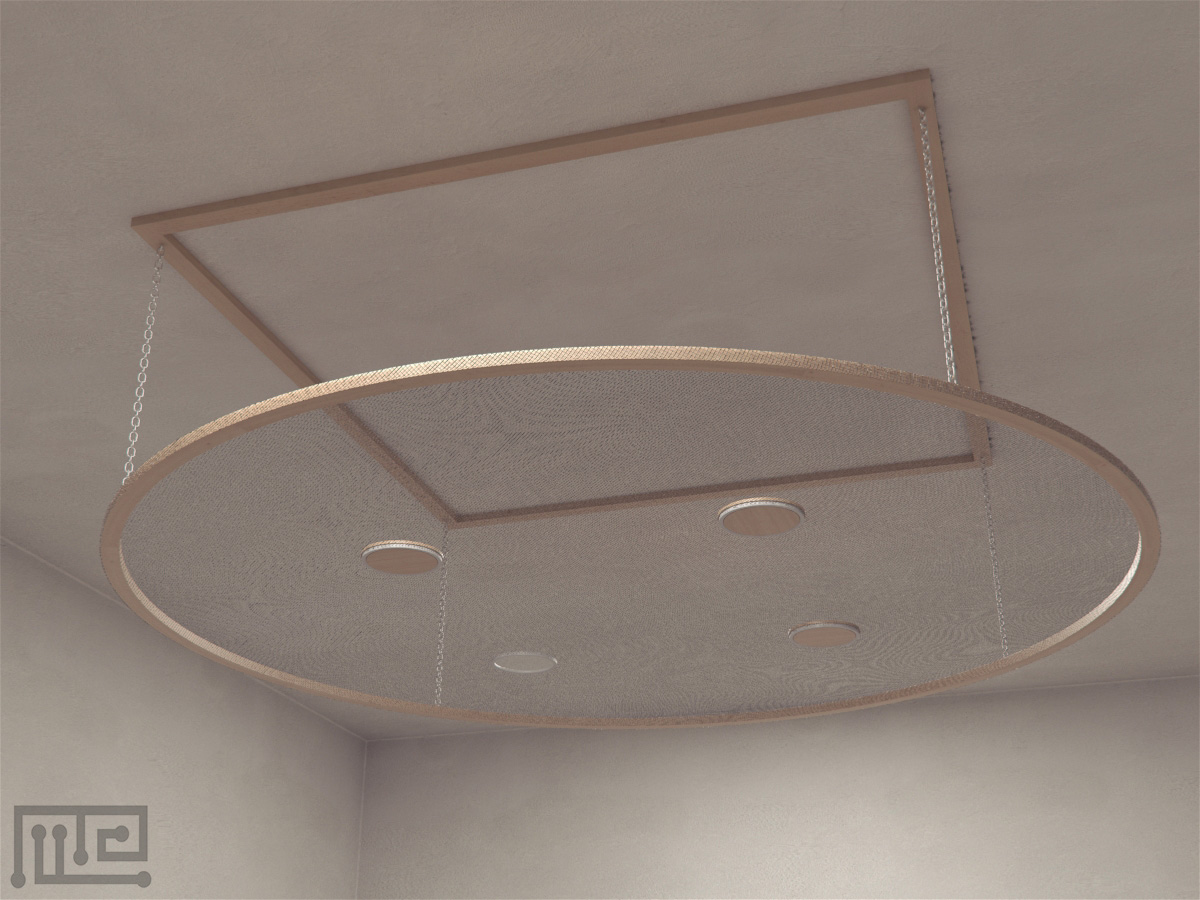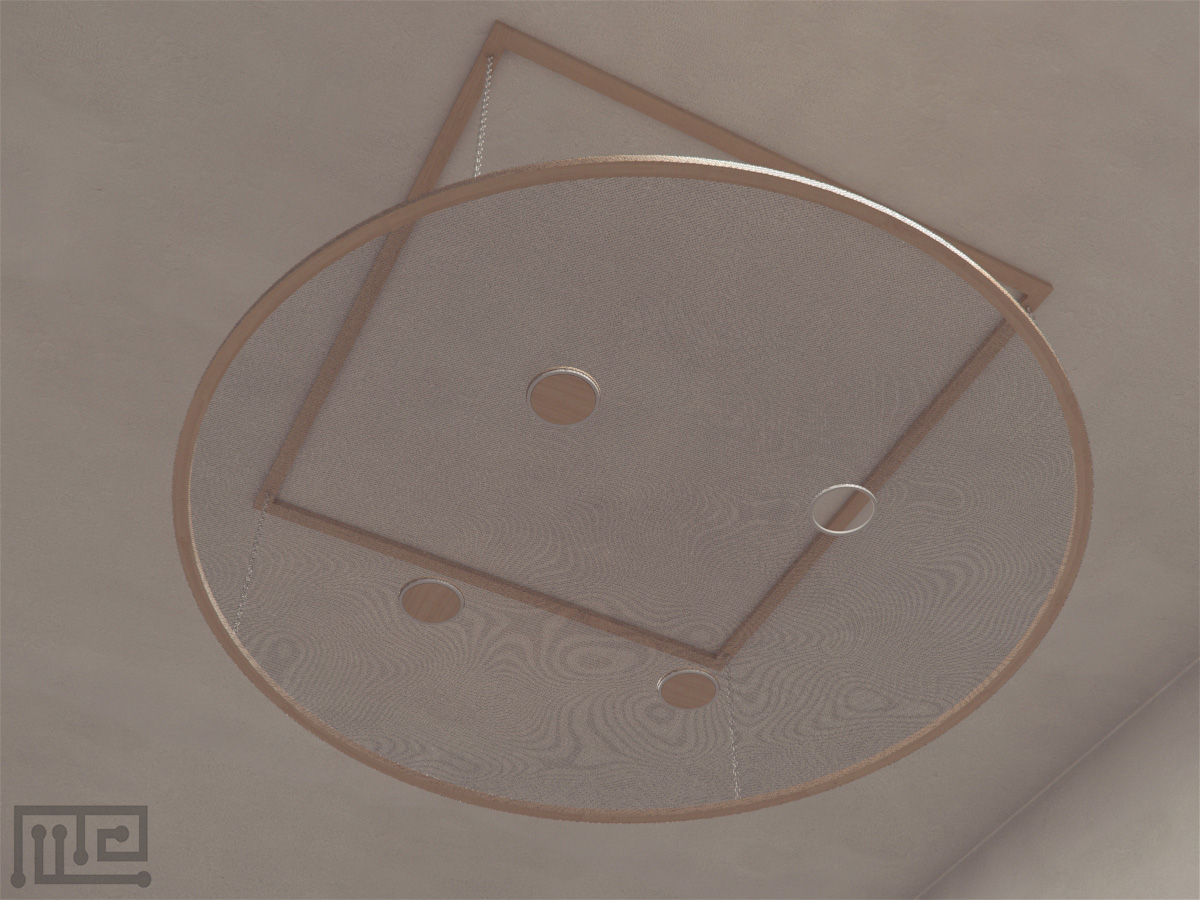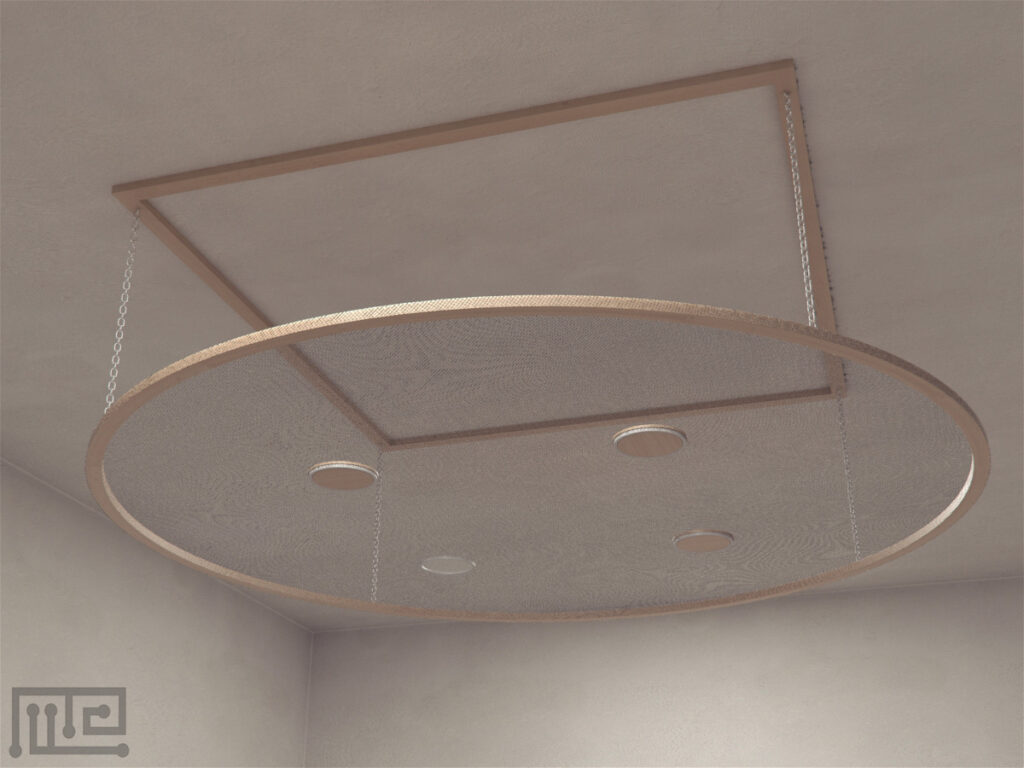The Inverted Maze was used by Stephane Valerio et al. (2010), to assess spatial navigation and head direction (HD) signal in rats.
The apparatus consisted of a circular wire mesh that was suspended 50-cm from the ceiling, with four evenly spaced holes that formed four possible escape exits from the maze. Each one of these holes could be closed with a piece of wood. The wire mesh was composed of metal screening with square size. The maze was in a room containing many salient visual cues including posters, a TV, a door, a blackboard, two windows along one wall, and a desk with a computer on it.
Mazeengineers offers the Inverted Maze for both mice and rats. Custom coloring and customization are available upon request.
Price & Dimensions
Mouse
$ 1490
+S&H- Diameter of circular wire mesh: 127cm
- Distance of wire mesh from ceiling: 34cm
- Diameter of holes in wire mesh: 10cm
- Length of wire mesh metal screening: 0.3cm
- Width of wire mesh metal screening: 0.3cm
- Note: Requires Roof Assembly & Installation, not included
Rat
$ 1690
+S&H- Diameter of circular wire mesh: 190cm
- Distance of wire mesh from ceiling: 50cm
- Diameter of holes in wire mesh: 15cm
- Length of wire mesh metal screening: 0.5cm
- Width of wire mesh metal screening: 0.5cm
- Note: Requires Roof Assembly and Installation, not included.
Documentation
Introduction
The Inverted Maze is a behavioral apparatus to assess navigational learning in rodents. Different mammals and rodents inhabiting subterranean environment locomote in 3 dimensional (3-D) space. Rodents’ head direction (HD) cells display direction-specific firing patterns during locomotion in vertical and horizontal planes (Calton & Taube, 2005; Taube, Stackman, Calton, & Oman, 2004). However, when they locomote in an upside-down position, they completely lose direction-specific firing in two-third of the HD cells (Valerio et al., 2020).
The Inverted Maze is specially designed to assess navigational learning of rodents in an inverted position in the absence of HD cell activity. It is comprised of circular wire mesh with square-shaped metallic screening, which is suspended in the ceiling. The subject utilizes an inverted position as aversive stimuli and searches for an exit hole to get back into an upright position. The subject utilizes distal visual cues and learns to find the exit hole. The Inverted Maze is effective in determining strategies through which subterranean rodents navigate in 3-D environments.
Other apparatuses that can be utilized to assess spatial navigation in rodents include the Circular Central Platform T Maze, the Crossword Maze, the Radial Arm Water Maze, and the Spatial Reorientation Maze.
Equipment and Apparatus
The Inverted Maze consists of a circular wire mesh (127 cm in diameter), which is suspended 34 cm down the ceiling with the help of metallic chains. The circular wire mesh is comprised of square sized metal screening (0.3 cm length x 0.3 cm width). The wire mesh is provided with four equidistant exit holes (10 cm diameter). The apparatus requires to be assembled on the ceiling of the room.
Task Performance
Properly clean the apparatus before task performance. Conduct the task in a room provided with noticeable visual cues such as doors, windows, tables, chairs, and posters. Conduct the task in 12 hr light/dark cycle. Keep three out of four exit holes closed with the help of a wooden piece throughout the task performance. For recordings, place the video recording system on the floor, facing towards the Inverted Maze. The Nodulus Ethovision can be used to assist with observations and recordings.
Pretraining
Place the subject in the center or the periphery of the Inverted Maze in an inverted position. Allow it to explore and search for the open exit hole. Conduct the trial for 3 minutes daily for 3 consecutive days.
For pretraining, place the subject near the open exit hole in an inverted position and allow it to find the hole and climb it to get into the normal upright position. Keep on increasing the distance of the subject from the open exit hole until it learns to find the exit hole from 20 cm away. Conduct 8 trials daily for 8 consecutive days.
Training
Place the subject in an inverted position in any of the four starting points (North, South, East, West). Allow the subject to find the open exit hole within 30 seconds. If the subjects can’t find the exit hole within 30 seconds, then guide it towards the open exit hole. After completing the trial, return the subject to its home cage. Conduct 4 trails daily for 2 consecutive days.
The Inverted Maze Escape Task
Allow the subject to find the open exit hole (within 30 seconds) in an inverted position from either one starting point or four different starting points. Conduct 4 trails daily for 2 consecutive days. The subject learns to spatially navigate in an inverted position if it successfully searches the exit hole in 3 out of 4 trials.
The Visual cue-based directional task
Train the subject to search the open exit hole (within 30 seconds) in an inverted position from either one starting point or two different starting points. Now place the subject in the center of the maze (facing each starting point in four trials) and allow it to search the open exit hole within 30 seconds. After completing the trial, remove the subject and place it in the home cage. Conduct 1 session with 4 trails. The subject learns to find the exit hole if it successfully searches the exit hole in 3 out of 4 trials.
Now rotate the maze to 90° that results in changing the location of the visual cues. Allow the subject to search the open exit hole (within 30 seconds). Conduct 1 session with 4 trials. The inability of the subject to search the exit hole in 3 out of 4 trials shows that the subject uses visual cues to navigate in an inverted position.
Now reverse the location of the open exit hole by selecting the hole situated in the opposite quadrant. Conduct 1 session with 4 trials by selecting new starting positions that remained in the same relative position to the open exit hole for both one and two starting position conditions. The subject can see the correct open exit hole from the starting position; if the subject finds the hole in 3 out of 4 trials,
To look for the extent to which the subject uses visual cues before being placed inverted on the maze, conduct two trials with the same starting point and open exit hole. Now in the third and the fourth trials, cover the subject with a cloth before being placed in the maze. If the subject finds the hole in 3 out of 4 trials, it means that subject doesn’t require visual cues which it sees before being placed in an inverted position.
Now cover the maze from the ceiling to the floor with the help of a black curtain to fully prevent the subject from observing visual cues. Allow the subject to search for the open exit hole (within 30 seconds). Conduct 1 session with 4 trails. If the subject finds the hole in 3 out of 4 trials, it means that subject doesn’t require distal visual cues to complete the task.
Place and trajectory task
Allow the subject to learn to reach a single open exit hole from two different starting points that require two opposite turns. Conduct 1 session with four trials. If the subject finds the hole in 3 out of 4 trials, it means that subject doesn’t require distal visual cues to complete the task.
Allow the subject to learn to reach two different open exit holes from two different starting points that require two opposite turns. Conduct 1 session with four trials. If the subject finds the hole in 3 out of 4 trials, it means that
Now allow subjects to learn to reach two different open exit holes from two different start points. The open exit holes must be in the same relative position from the starting points so that the subject has to take a right turn to reach the open exit hole. Conduct 1 session with four trials. If the subject finds the hole in 3 out of 4 trials, it means that subject uses egocentric learning to complete the task.
Now place the subject in the center of the maze (facing each starting point in four trials) and allow it to search the open exit hole within 30 seconds. Now conduct 1 session of the Inverted Maze Escape task. After this, cover the maze from the ceiling to the floor with the help of a black curtain to fully prevent the subject from observing visual cues. Allow the subject to search for the open exit hole (within 30 seconds). Conduct 1 session with 4 trails.
Literature Review
Investigation of navigational learning of Long Evan Rats in an inverted position
Valerio et al. (2011) investigated the spatial navigation in an inverted position in the Long Evan Rats. The study comprised of three experiments. The subjects were first pre-trained, trained, and then tested on the Inverted Maze. The Inverted Maze Escape Task, the Visual cue, and the directional task, and the Place vs. trajectory tasks were conducted to understand the navigational learning in an inverted position. In the Inverted Maze Escape Task, the subject has to navigate the maze in an inverted position and search for the exit hole. One group has to start from one start point, and the other group has to start from four start points. In the Visual cue and directional task, one group has to start from one start point, and the other group has to start from two start points and tested for visual cues and direction for completing the task. In the Place vs. trajectory task, three groups of subjects were tested to find if they learn to reach a place or learn distinct trajectories towards the exit hole. The results of the Inverted Maze Escape Task revealed that the group which started from four points was not able to learn to reach the open exit holes even after 30 days of training. Contrastingly, the group with 1 starting point learned to reach the open exit holes within 6 days of training. The results of the Visual cue-based directional task revealed that both groups were able to use distal visual cues to complete the task. However, it was not flexible as both the groups were not able to complete the task when released from a novel central point as a starting position. The results of the Place vs. trajectory task showed that subjects do not learn to reach a place; they learn distinct trajectories towards the open exit holes. This research concluded that the Long Evan Rats navigate in an inverted position by using a directional strategy by making use of visual cues.
Data analysis
- Escape latency per trial
- Percentage of correct trials per session
Strengths and Limitations
Strengths
The Inverted Maze task is easy to perform. It can be used to understand multiple strategies utilized to navigate in an inverted position. The maze can be easily rotated, and external visual cues can be controlled.
Limitations
The task performance is simple but tiresome and time-consuming. Repeated handling of subjects may cause stress to the subjects. The inverted position as an aversive stimulus may cause stress to the subject. The presence of unsolicited surrounding cues may alter task performance.
Summary
- The Inverted Maze is a behavioral task to assess navigational learning in rodents.
- It consists of a suspended circular platform made of wire mesh with four exit holes.
- The Inverted Maze uses the inverted position of the subject as an aversive stimulus to find an exit hole to get into an upright position.
- The subject uses distal visual cues to find the open exit hole.
- The task performance is easy but time-consuming.
- The Inverted Maze can be used to assess different strategies through which rodents navigate in inverted positions.
References
- Calton, J. L., & Taube, J. S. (2005). Degradation of head direction cell activity during inverted locomotion. The Journal of neuroscience : the official journal of the Society for Neuroscience, 25(9), 2420–2428. https://doi.org/10.1523/JNEUROSCI.3511-04.2005
- Taube, J. S., Stackman, R. W., Calton, J. L., & Oman, C. M. (2004). Rat head direction cell responses in zero-gravity parabolic flight. Journal of neurophysiology, 92(5), 2887–2997. https://doi.org/10.1152/jn.00887.2003
- Valerio, S., Clark, B. J., Chan, J. H., Frost, C. P., Harris, M. J., & Taube, J. S. (2010). Directional learning, but no spatial mapping by rats performing a navigational task in an inverted orientation. Neurobiology of learning and memory, 93(4), 495–505. https://doi.org/10.1016/j.nlm.2010.01.007
Request a quote
"*" indicates required fields




